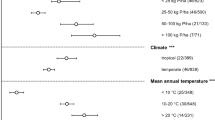Abstract
Deficiencies in essential chemical elements were diagnosed for two soils in a pot trial, using a subtractive technique and two different test plants: perennial ryegrass for ‘major’ elements and white clover for ‘minor’ elements. This information was required in a pastoral area to permit field trials to be designed with a suitably fortified superphosphate as the fertilizer input. The trials themselves are wanted to provide economic advice soundly based in relation to nutritional needs of pasture plants and grazing animals. Accordingly, a complex argument has been developed to justify using simple 3-level trials with physiologically balanced fertilizer instead of conventional multilevel factorial types; also to show how the simple trials should be designed.
Similar content being viewed by others
References
Agricultural Research Council (1980) The nutrient requirements of ruminant livestock. Comm Agric Bur, Farnham Royal, Slough, pp 309–311
Elliott IL and Lynch PB (1958) Techniques of measuring pasture production in fertilizer trials. NZ J Agric Res 1:498–521
Hagin J (1969) Problems of fertilizer requirement prediction in intensive agriculture. Proc 7th Coll Int Potash Inst, pp 185–189
Hauser GF (1970) A standard guide to soil fertility investigations on farmers' fields. Soils Bull 11, FAO, Rome
Hauser GF (1971) Specialized techniques and experimental designs used by FAO in large scale and fertility investigations in developing countries. Int Sympo Soil Fert Evaluation Prof 1:549–561
Hauser GF (1974) In Fernandez VH ed., Fertilizers, crop quality and economy, pp 992–995. New York: Elsevier
Heady EO, Pesek JT and Brown WG (1955) Crop response surfaces and economic optima in fertilizer use. Iowa Agric Exp Sta Res Bull 424, 293–332
Heady EO and Dillon JL (1961) Agricultural production functions. Ames: Iowa State University Press
Jacob A and von Uexkull H (1958) Fertilizer use. Verlagsgesellschaft fur Ackerbau, Hannover
Karlovsky J (1962) Method of assessing utilization of phosphorus on permanent pasture. Trans Int Soc Soil Sci Comm IV and V, 726–730
Karlovsky J (1966) Assessing fertilizer maintenance requirements. NZ Agric Sci, 1:15–18
Karlovsky J (1975) How much phosphate do we really need? NZ Agric Sci 9:146–161
Karlovsky J (1981) Cycling of nutrients and their utilization by plants in agricultural ecosystems. Agro-Ecosystems 7:127–144
Middleton KR and Toxopeus MRJ (1973) Diagnosis and Measurement of multiple soil deficiences by subtractive technique. Plant and Soil 50:219–226
Middleton KR (1973) Design and analysis of superphosphate trials on high producing permanent pasture. NZ Agric Res 16:497–502
Middleton KR (1973) Monetary value of pasture especially in relation to fertilizer trials. NZ J Agric Res 16:503–507
Middleton KR (1976) Fertilizer research in New Zealand. NZ Agric Sci 10:156–164
Middleton KR (1977) Economic control of fertilizer on grass-clover pasture through the Mitscherlich-Baule-Spillman concept. NZ Agric Sci 11:87–93
Middleton KR (1980) The fertilizer economy of high producing pastoral systems. Fertilizer Research 1:5–27
Middleton KR (1982) An old chestnut (letter to the editor) J Australian Inst Agric Sci 48, 49
Middleton KR (1983) Economic control of fertilizer in highly productive pastoral systems. I A theoretical framework for the fertilization problem. Fertilizer Research (in press)
Middleton KR and Smith GS (1974) Estimating the fertilizer rate for maintaining permament pasture. Proc 10th Int Soil Sci Congr 4:151–159
Mideleton KR and Smith GS (1978) The concept of a climax in relation to the fertilizer input of a pastoral ecosystem. Plant and Soil 50:595–614
Nye PH (1968) Processes in the root environment. J Soil Sci 19:205–215
Officer RR and Dillon JL (1968) Probability and statistics in agricultural research and extension. J Australian Inst Agric Sci 34:1321–1329
Rae AN (1972) Bayesian decision theory in agricultural experimentation and extension. NZ Agric Sci 6:3–6
Scott RS (1971) Pasture aging in relation to method of yield estimation. Proc NZ Grassland Assoc 33:105–114
Smith GS Middleton KR and Smith RG (1976) Diagnosis of multiple plant nutrient deficiencies in soils of the West Coast of the South Island. NZ J Exp Agric 4:423–427
Smith GS and Middleton KR (1978) Sodium and potassium content of topdressed pastures in New Zealand in relation to plant and animal nutrition. NZ J Exp Agric 6:217–225
Smith GS, Middleton KR and Edmonds AS (1978) A classification of pastures and fodder plants according to their ability to tranlocate sodium from their roots into aerial parts. NZ J Exp Agric 6: 183–188
Author information
Authors and Affiliations
Rights and permissions
About this article
Cite this article
Middleton, K. Economic control of fertilizer in highly productive pastoral systems. II. Designing field trials with physiologically balanced fertilizer through subtractive pot experiments. Fertilizer Research 4, 315–330 (1983). https://doi.org/10.1007/BF01054005
Accepted:
Issue Date:
DOI: https://doi.org/10.1007/BF01054005




